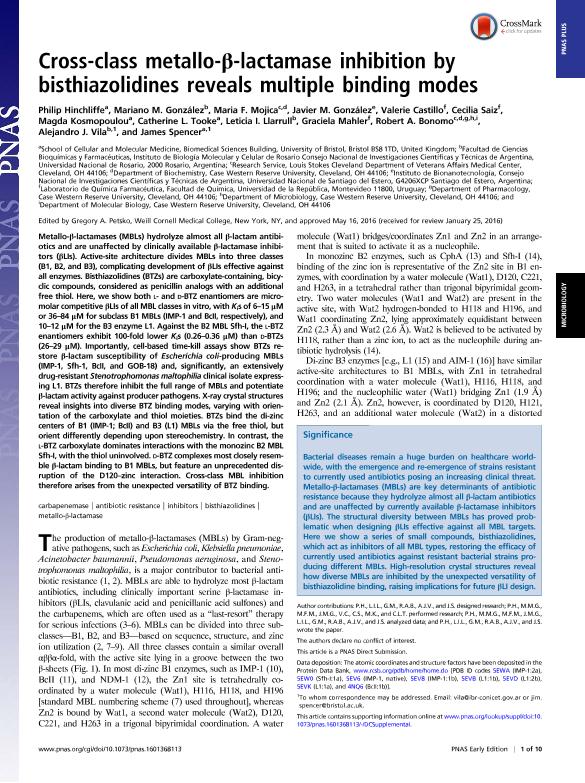Mostrar el registro sencillo del ítem
dc.contributor.author
Hinchliffe, Philip
dc.contributor.author
Gonzalez, Javier Marcelo

dc.contributor.author
Mojica, María
dc.contributor.author
Gonzalez, Javier Marcelo

dc.contributor.author
Castillo, Valerie
dc.contributor.author
Saiz Garcia, Cecilia

dc.contributor.author
Kosmopoulou, Magda
dc.contributor.author
Tooke, Catherine
dc.contributor.author
Llarrull, Leticia Irene

dc.contributor.author
Mahler, Graciela
dc.contributor.author
Bonomo, Robert
dc.contributor.author
Vila, Alejandro Jose

dc.contributor.author
Spencer, James
dc.date.available
2018-06-05T18:10:09Z
dc.date.issued
2016-06
dc.identifier.citation
Hinchliffe, Philip; Gonzalez, Javier Marcelo; Mojica, María; Gonzalez, Javier Marcelo; Castillo, Valerie; et al.; Cross-class metallo-β-lactamase inhibition by bisthiazolidines reveals multiple binding modes; National Academy of Sciences; Proceedings of the National Academy of Sciences of The United States of America; 113; 26; 6-2016; 3745-3754
dc.identifier.issn
0027-8424
dc.identifier.uri
http://hdl.handle.net/11336/47337
dc.description.abstract
Metallo-β-lactamases (MBLs) hydrolyze almost all β-lactam antibiotics and are unaffected by clinically available β-lactamase inhibitors (βLIs). Active-site architecture divides MBLs into three classes (B1, B2, and B3), complicating development of βLIs effective against all enzymes. Bisthiazolidines (BTZs) are carboxylate-containing, bicyclic compounds, considered as penicillin analogs with an additional free thiol. Here, we show both L- and D-BTZ enantiomers are micromolar competitive βLIs of all MBL classes in vitro, with Ki sof6-15 μM or 36-84 μM for subclass B1 MBLs (IMP-1 and BcII, respectively), and 10-12 μM for the B3 enzyme L1. Against the B2 MBL Sfh-I, the L-BTZ enantiomers exhibit 100-fold lower Ki s (0.26-0.36 μM) than D-BTZs (26-29 μM). Importantly, cell-based time-kill assays show BTZs restore β-lactam susceptibility of Escherichia coli-producing MBLs (IMP-1, Sfh-1, BcII, and GOB-18) and, significantly, an extensively drug-resistant Stenotrophomonas maltophilia clinical isolate expressing L1. BTZs therefore inhibit the full range of MBLs and potentiate β-lactam activity against producer pathogens. X-ray crystal structures reveal insights into diverse BTZ binding modes, varying with orientation of the carboxylate and thiol moieties. BTZs bind the di-zinc centers of B1 (IMP-1; BcII) and B3 (L1) MBLs via the free thiol, but orient differently depending upon stereochemistry. In contrast, the L-BTZ carboxylate dominates interactions with the monozinc B2 MBL Sfh-I, with the thiol uninvolved. D-BTZ complexes most closely resemble β-lactam binding to B1 MBLs, but feature an unprecedented disruption of the D120-zinc interaction. Cross-class MBL inhibition therefore arises from the unexpected versatility of BTZ binding.
dc.format
application/pdf
dc.language.iso
eng
dc.publisher
National Academy of Sciences

dc.rights
info:eu-repo/semantics/openAccess
dc.rights.uri
https://creativecommons.org/licenses/by-nc-sa/2.5/ar/
dc.subject
ANTIBIOTIC RESISTANCE
dc.subject
BISTHIAZOLIDINES
dc.subject
CARBAPENEMASE
dc.subject
INHIBITORS
dc.subject
METALLO-Β-LACTAMASE
dc.subject.classification
Otras Ciencias Biológicas

dc.subject.classification
Ciencias Biológicas

dc.subject.classification
CIENCIAS NATURALES Y EXACTAS

dc.title
Cross-class metallo-β-lactamase inhibition by bisthiazolidines reveals multiple binding modes
dc.type
info:eu-repo/semantics/article
dc.type
info:ar-repo/semantics/artículo
dc.type
info:eu-repo/semantics/publishedVersion
dc.date.updated
2018-05-28T14:39:12Z
dc.journal.volume
113
dc.journal.number
26
dc.journal.pagination
3745-3754
dc.journal.pais
Estados Unidos

dc.journal.ciudad
Washington
dc.description.fil
Fil: Hinchliffe, Philip. University of Bristol; Reino Unido
dc.description.fil
Fil: Gonzalez, Javier Marcelo. Consejo Nacional de Investigaciones Científicas y Técnicas. Centro Científico Tecnológico Conicet - Rosario. Instituto de Biología Molecular y Celular de Rosario. Universidad Nacional de Rosario. Facultad de Ciencias Bioquímicas y Farmacéuticas. Instituto de Biología Molecular y Celular de Rosario; Argentina
dc.description.fil
Fil: Mojica, María. Louis Stokes Cleveland Department of Veterans Affairs Medical Center; Estados Unidos. Case Western Reserve University; Estados Unidos
dc.description.fil
Fil: Gonzalez, Javier Marcelo. Universidad Nacional de Santiago del Estero. Instituto de Bionanotecnología del Noa. Consejo Nacional de Investigaciones Científicas y Técnicas. Centro Científico Tecnológico Conicet - Tucumán. Instituto de Bionanotecnología del Noa; Argentina
dc.description.fil
Fil: Castillo, Valerie. Universidad de la República; Uruguay
dc.description.fil
Fil: Saiz Garcia, Cecilia. Universidad de la República; Uruguay
dc.description.fil
Fil: Kosmopoulou, Magda. University of Bristol; Reino Unido
dc.description.fil
Fil: Tooke, Catherine. University of Bristol; Reino Unido
dc.description.fil
Fil: Llarrull, Leticia Irene. Consejo Nacional de Investigaciones Científicas y Técnicas. Centro Científico Tecnológico Conicet - Rosario. Instituto de Biología Molecular y Celular de Rosario. Universidad Nacional de Rosario. Facultad de Ciencias Bioquímicas y Farmacéuticas. Instituto de Biología Molecular y Celular de Rosario; Argentina
dc.description.fil
Fil: Mahler, Graciela. Universidad de la República; Uruguay
dc.description.fil
Fil: Bonomo, Robert. Louis Stokes Cleveland Department of Veterans Affairs Medical Center; Estados Unidos. Case Western Reserve University; Estados Unidos
dc.description.fil
Fil: Vila, Alejandro Jose. Consejo Nacional de Investigaciones Científicas y Técnicas. Centro Científico Tecnológico Conicet - Rosario. Instituto de Biología Molecular y Celular de Rosario. Universidad Nacional de Rosario. Facultad de Ciencias Bioquímicas y Farmacéuticas. Instituto de Biología Molecular y Celular de Rosario; Argentina
dc.description.fil
Fil: Spencer, James. University of Bristol; Reino Unido
dc.journal.title
Proceedings of the National Academy of Sciences of The United States of America

dc.relation.alternativeid
info:eu-repo/semantics/altIdentifier/doi/http://dx.doi.org/10.1073/pnas.1601368113
dc.relation.alternativeid
info:eu-repo/semantics/altIdentifier/url/http://www.pnas.org/content/113/26/E3745
Archivos asociados
